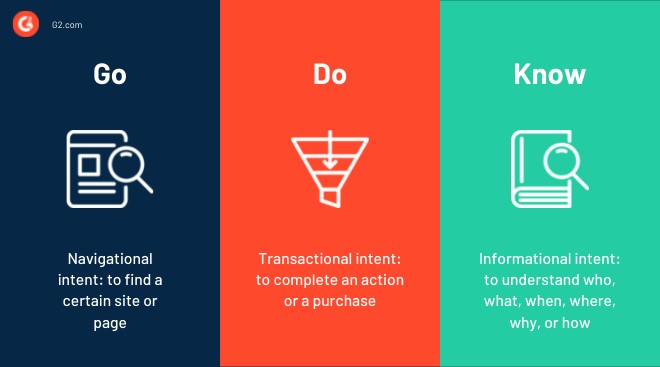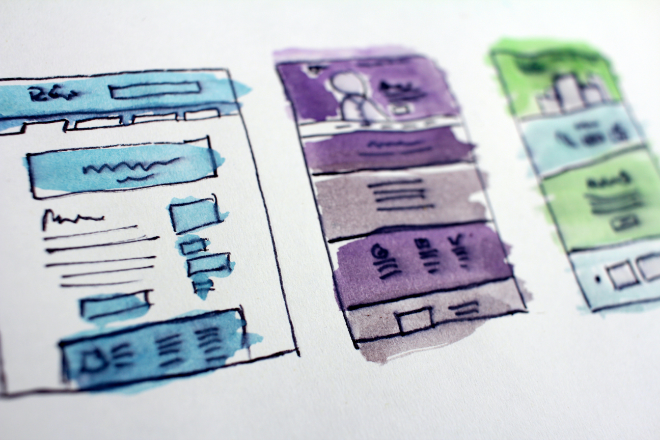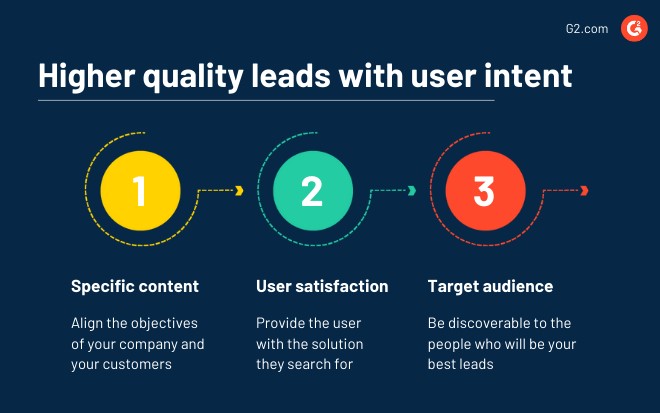SEO User Intent – 3 Ways it Drives Higher Lead Quality

Low-quality leads don’t support a business.
If you’re looking to improve lead quality, it’s time to start using SEO user intent. High-quality leads are essential in keeping a successful business going, and user intent can help you achieve this goal.
SEO user intent helps align the objectives of your company and your customers. Giving people what they actually want, instead of what you think they want, will attract people ready to buy from you.
What is SEO user intent?
User intent, also known as search intent, is the main goal a user tries to achieve when searching for a query. It can be classified into three different categories: go, do, and know.

A go user intent is a navigational search in which the user tries to find a certain site or page. For example, if someone types G2 accounting into Google, they’re likely to navigate to the G2 accounting category page without typing out the entire URL.
A do user intent is a transactional search. In this type of search, the user is in the buyer’s journey and intends to complete an action or a purchase. Transactional intent is a conversion of the user. A few examples of a “do user intent” are signing up for a newsletter or buying a new watch.
A know user intent is an informational search. When a user is looking for information, search queries will likely include who, what, where, when, why, or how. An example of an informational search would be a user searching for an Apple store location near them.
User intent is crucial when developing your SEO strategy. Tying the terms SEO and user intent together will help you successfully funnel in and convert users. SEO user intent means thinking critically about the intent behind the keywords and audience you’re targeting and optimizing your content or site to better align with the user’s end goal.
For example, G2 is the place people go to purchase software. The intent is transactional and informational, so the G2 site is optimized to provide users with pricing information, reviews, product comparisons, informational articles, and links to purchase. G2 ties its understanding of user intent to SEO through the target keywords, metadata, and content. User intent is satisfied, and with SEO in mind, it is highly searchable, creating the perfect atmosphere for G2 to attract high-quality leads and convert them into consumers.

Why does SEO user intent drive higher quality leads?
SEO user intent helps your business keep best practices in mind. The content you create, and the type of platforms you use will align with what your target audience wants to discover. If you’re giving the people what they want, i.e., satisfying their search queries, they’re more likely to become your consumer. This is how SEO user intent drives higher quality leads. You and the user are aligned, and therefore, they’re more likely to purchase from you.
Besides meeting the users’ needs, SEO user intent also ensures that your business is visible to users. Satisfying user intent is important to search engines like Google. If your content and the intent are mismatched, search engines won’t rank you, and users will bounce from your site. Providing relevant and compelling content will convert your users into potential prospects willing to make a purchase.
SEO user intent helps you find your target audience by using SEO best practices for discoverability and creating the content they need. If you offer users something of value, you’ll have quality leads in your pipeline.
3 ways SEO user intent drives higher lead quality
SEO user intent ensures that you bring in high-quality leads because it aligns your business goals with the user’s goals. The three most important ways that SEO user intent drives better lead quality are creating user-specific content, driving user satisfaction, and targeting the right audience.

Content is specific
Curating your content strategy to align with SEO user intent, whether it’s the content you produce or the content of your website, will generate higher quality leads. The content you use to present your business to consumers tells them who and what you are. Setting the right tone attracts your ideal client, helping you find the perfect people to sell to.
Content makes users find you online. When this is consistent with your core purpose as a business, you’re telling people what you care about. By using content specific to your niche, you’ll become highly discoverable in your niche. Therefore, people who’re potential consumers in your industry can find you through your content.
If you’re creating too broad content, users who aren’t aligned with your niche can also find you. While it’s good to be visible to new users, it’s not beneficial to be discoverable by just anybody. For example, if you’re a marketing consulting firm, putting out accounting blog content doesn’t help find new leads. You’ll be making your presence known to people who don’t have any use for your services. This will result in low-quality leads.
Instead, imagine if the marketing consulting firm only put out blog posts related to the marketing field. The posts would still be diverse in topics ranging from SEO strategy advice to an explanation of why your marketing campaign isn’t working. The diversity of the specific content will attract leads who face the problems your business can solve, providing you with new, high-quality leads to convert.
Researching to see what the search intent is in your industry like will help you create content specific to your niche. Potential leads will find you when you sync your business’ value with the content you produce.
User satisfaction: The solution they’re looking for
Using SEO user intent helps ensure user satisfaction, resulting in quality leads. You should have the solution ready for searchers, so they’ll be in your purchase funnel as soon as they get to your page.
User satisfaction is at the heart of user intent. To satisfy the user, you have to understand what they’re looking for and deliver it. Understanding users’ expectations and providing them the right solution builds trust between you and your prospects. Your company will be their go-to place when looking for a solution in your industry and niche.
For example, if you own a small bakery and a user comes to your page to buy cupcakes, you would want to have an order button and an overview of your offerings the moment someone visits the page. The user’s intent here would be transactional, so the solution they need is a place to order and a menu of what’s available. The faster your page delivers the solution to the user, the better.
Now, let’s say someone visits your bakery’s site, but instead of a cupcakes menu and an order form, the first thing they see are links to your social media platforms and blog posts. While these are great platforms for social visibility, they aren’t categories that would align with your ideal client’s intent.
You don’t just want people to follow you on Instagram or read about how you developed a vegan cupcake recipe; you want them to buy from your bakery. The solutions you’re providing don’t reflect the actual user intent and will not help you convert leads. Eventually, your page won’t rank because your bounce rates will be super high.
Satisfying potential clients as quickly as possible is the lesson to learn from SEO user intent. The faster you can deliver what people need, the sooner you can advance them in the buying funnel. If you keep an eye on the solutions your users want, you’ll produce quality leads and fit right into your niche.
Stand out to your target audience
Using SEO user intent will help you find your target audience. Not only will you understand who your ideal customer is, but also how to reach them. Finding your target audience through SEO user intent requires using the practices mentioned above. By doing so, you’ll reach higher quality leads because you’re intentionally marketing to the right people.
Your company ultimately decides what it offers and what content it produces; however, it’s important to let your audience influence these decisions as well, which is what user intent is all about.
Implement aspects of brand monitoring to help you dive deeper into understanding user intent, such as researching the keywords you’re using, looking at what your competitors do, and keeping track of industry trends. This will ensure that you’re providing the best content and solutions possible for your target audience in the industry. When you’re a top performer, more people will trust and come to you when it’s time for them to make a purchase.
Intent data can also be a useful tool when it comes to deciphering user intent. Intent data is collected information that indicates if someone will buy from you and where they are in the buyer’s journey.
Collecting intent data takes time and experimentation, so it’s ok not to start with this information right away. However, it’s important to integrate this data into your strategy to keep your lead quality high. You can use the data in many ways:
- See if your target audience is evolving
- Check how they’re reacting to the content you put out
- Discover if your conversion efforts are successful
User intent is dynamic, so researching it is important.
Maintaining a competitive advantage while using the best SEO user intent practices will ensure that users find and invest in you when it’s time for them to enter the buyer’s journey.
Optimize intent
SEO user intent drives quality leads because it helps you put your best foot forward. Understanding user intent and your target audience will ensure that you provide consumers what they need in the most convenient way possible. If you can immediately deliver quality results, you’ll gain respect and trust from consumers in your niche. You’ll also become the go-to place for your services. Providing the right solutions to the right people will help you optimize your processes, so it’s crucial to start using the underlying information from SEO user intent today.

